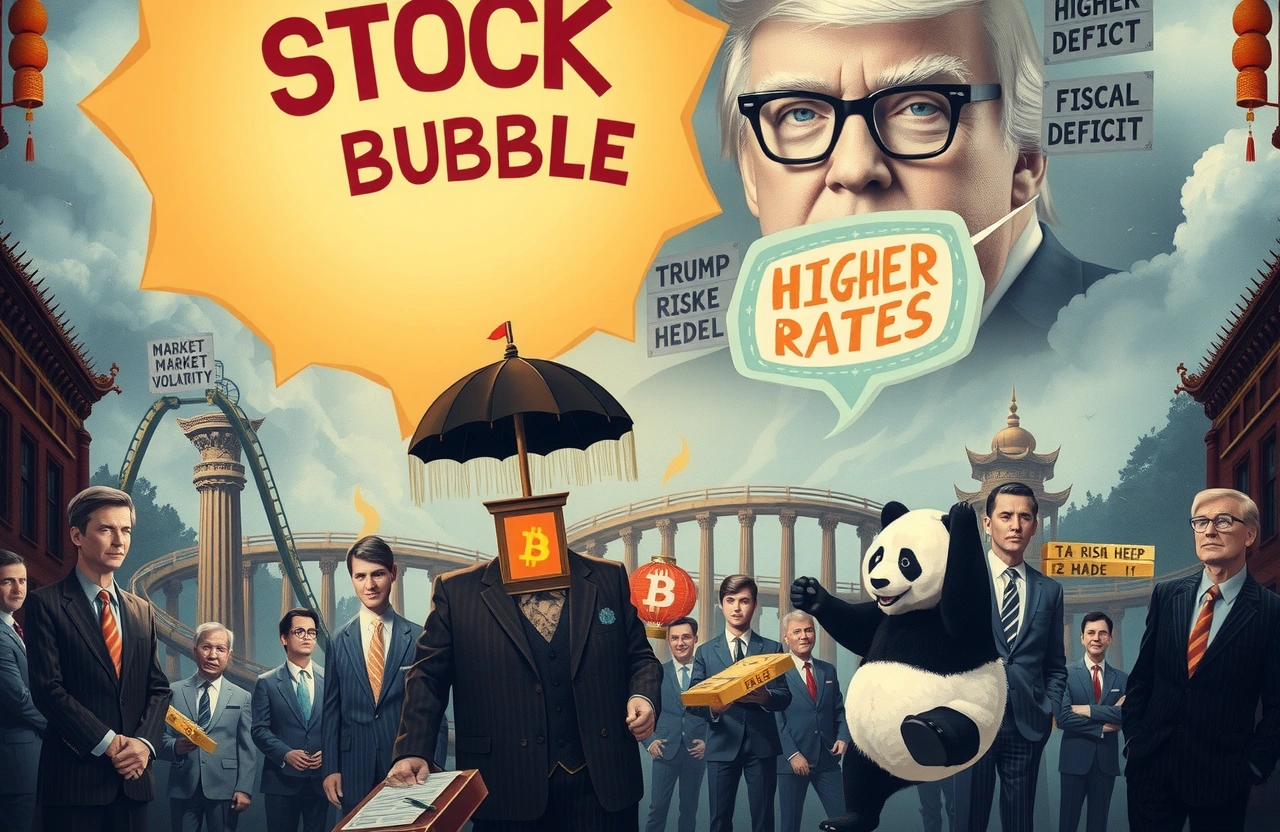The escalating conflict between President Trump and Federal Reserve Chair Jerome Powell has entered a critical phase that could trigger unprecedented market movements. Bank of America Chief Investment Strategist Michael Hartnett warns Wall Street might ‘surrender’ before the Federal Reserve by deliberately creating a stock market bubble. This preemptive capitulation would aim to finance Trump’s proposed $4 trillion ‘Great Beautiful Act’ spending program through artificial asset inflation—a dangerous gamble that could accelerate nominal GDP growth while amplifying inflationary pressures and Treasury market instability.
Key Takeaways
- Wall Street could proactively create a stock bubble to fund Trump’s fiscal agenda before Federal Reserve policy shifts
- A Trump-Powell confrontation may trigger Fed leadership changes interpreted as dovish signals by markets
- Record $7T US government spending creates urgent pressure for interest rate reductions
- Surging stock markets may indicate bubble formation via Hartnett’s VIBBE framework signals
- Recommended hedges include shorting USD/30Y Treasuries and long gold/crypto/tech barbell strategy
Wall Street’s Preemptive Surrender Strategy
The financial markets appear poised to force the Federal Reserve’s hand through anticipatory maneuvers. According to Michael Hartnett’s analysis, traders are likely to ‘run ahead’ of monetary policy shifts by deliberately inflating equity valuations. This artificial bubble would serve as a funding mechanism for Trump’s proposed ‘Great Beautiful Act’—a fiscal package estimated to cost $4 trillion over the next decade. Such Wall Street surrender before the Fed represents a radical departure from traditional market responses to monetary policy, effectively monetizing fiscal expansion before formal central bank accommodation.
The Trump-Powell Conflict Escalation
President Trump’s public pressure campaign against the Fed Chair—including calls for interest rates to drop to 1%—creates unprecedented tension in monetary-fiscal relations. Historical precedents suggest federal reserve chairs typically lose their positions over three core conflicts: interest-rate disagreements, currency management disputes, or corruption allegations. Should Trump attempt Fed leadership removal, markets would instantly interpret this as dovish policy capitulation. This perception shift could spark rapid asset repricing independent of economic fundamentals.
The Mechanics of Policy Front-Running
Hartnett predicts markets will transition from 2025’s anticipated ‘detox mode’ (high rates + fiscal restraint) to ‘nominal GDP boom mode’ (rate cuts + tax reductions) much earlier than policymakers intend. Traders are positioned to execute this pivot through:
- Anticipatory positioning in rate-sensitive sectors
- Artificial multiple expansion in momentum stocks
- Bifurcated market behavior favoring speculative assets
Fiscal Pressures Driving Imminent Policy Shifts
With US government spending now exceeding $7 trillion annually, Hartnett identifies constrained fiscal options challenging deficit management. The breakdown reveals:
| Spending Category | Amount | Flexibility |
|---|---|---|
| Mandatory Spending | $4T | Non-negotiable |
| Discretionary Spending | $1T | Already preserved |
| Defense Allocation | $1T | Politically untouchable |
| Interest Expense | $1T | Primary pressure point |
The Rate Cut Imperative
Reducing debt service costs presents the only viable fiscal lever. Hartnett calculates:
- 3.25% Fed Funds rate could stabilize debt burdens
- 2% rate would save approximately $200B annually
- Trump’s proposed 1% target savings exceed $300B/year
Bond Market Paradox
Aggressive easing presents a conundrum: short-term relief might prompt yield curve inversion as long-term Treasury investors price in future inflation. Historical evidence reveals this dynamic—50 basis point Federal Reserve cuts in 2024 triggered abnormal long-bond volatility. Such distortions invalidate traditional portfolio hedges while elevating gold and crypto as institutional hedges against policies eroding dollar credibility.
Bubble Warning Signals Emerging
Hartnett’s proprietary VIBBE framework identifies bubble formation through five converging indicators:
VIBBE Bubble Checklist
- Valuation Extremes: Forward P/E ratios 25% above historic norms
- Inflation Acceleration: Rising CPI coinciding with strong GDP
- Bond Market Stress: Widening credit spreads amid policy shifts
- Market Breadth Degradation: Narrowing leadership to momentum stocks
- Exponential Price Movement: Parabolic 45°+ equity trajectories
The Smoking Gun Signal
The definitive bubble confirmation occurs when stocks hit new highs while disregarding climbing bond yields and inflation expectations. Recent benchmark breaches—including the S&P 500 surpassing 5,500—exhibit this precise divergence. These conditions historically precede major volatility events when fundamentals reassert themselves over momentum-driven trading.
Strategic Portfolio Recommendations
Navigating potential policy capitulation requires unconventional positioning. Hartnett’s barbell approach balances asymmetric risk:
Four Tactical Pillars
Asymmetric Bets
- Short USD positions: Hedge against dollar devaluation via currency futures
- Long gold/crypto: Physical gold ETFs + Bitcoin allocation (15-20% combined)
Rates Sensitivity
- Short 30Y Treasury Bonds: Position for steepening curve via TLT put options
- Barbell equity allocation: 60% US tech leaders + 40% international value stocks
The accelerating collision between fiscal ambitions and monetary independence demands investor vigilance. Markets appear willing to gamble on inflationary asset reflation to front-run policy normalization. While this Wall Street surrender before the Fed might temporarily buoy portfolios, dispersion trades favoring quality and liquidity will outperform during inevitable turbulence. Conduct scenario planning incorporating yield curve normalization stress-tests and portfolio margining safety buffers.
Review hedges against both inflationary spikes and policy accidents. Historical analysis shows politically-driven Fed transitions create volatility comparable to actual recessions—2022 UK gilt crisis exemplifies this vulnerability. Prudent investors maintain barbell allocations across uncorrelated assets until policy pathways emerge. Consult fiduciary advisors regarding tail-risk hedging before potential October volatility windows.




